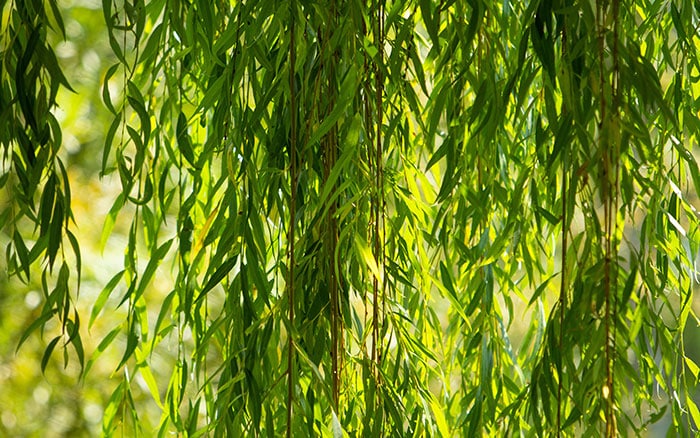Embellishing your garden using natural materials or using them to create structures and form in your garden is a fantastic way of making the most of nature. Find out more on creating living structures with willow in the garden…
What is willow?
Willow is instantly recognisable with the silky, silver catkins and the drooping foliage that has an enchanting effect.
The genus is native to temperate regions of the northern hemisphere.
Salix alba (white willow) is native to Europe and western and central Asia. The huge, sweeping foliage is typically seen next to water spots where it hangs beautifully over the water’s edge. Not only does it look stunning, and provide shade on a sunny day, but it also has plenty to offer for wildlife.
Among the benefits for wildlife, caterpillars, moths, bees, and birds will all be able to make the most of white willow.
The leaves are a food source for caterpillars of some moth species, whilst the catkins provide nectar for bees. Meanwhile the branches of these trees provide shelter and nesting sites for birds.
Salix alba (white willow)
- Flowers in spring
- Fully hardy
- Can grow higher than 12m
- Moist but well-drained or poorly drained
- Full sun
- Exposed or sheltered

Wow factor
The beauty of willows goes far further than their appearance. In fact, the plants have long been used as pain relief. Interestingly, the compound found in Aspirin, salicin, is found in Salix bark.
Using willow in the garden
As mentioned, willow provides marvellous habitats for wildlife. When spring comes, these plants are one of the first to flower, so are an early source of nectar for pollinators like bees. As well as the tree providing shelter for birds, the cover of the canopy can also help fish by providing shade and stabilising the banks of streams.
The vigorous growth of willows makes them a great addition for wildlife gardens because they will quickly establish to offer shelter.

Living willow structures
One of the other great advantages of growing willow in the garden is the continuous supply of materials that can be used to make willow structures like trellises.
This can be done by coppicing or pollarding to get straight but malleable branches to create trellises.
Although, one thing to be aware of when doing this is that willows will root easily. Therefore, if you don’t want your living structure to start growing, use dried wood to support the posts and stick these directly into the ground rather than the fresh wood of the willow.

How to do it
Once you’ve chosen the variety of willow to plant, you can prepare the site by marking out the design shape, whether that’s a wigwam, walkway, or dome. Then, the whips, or rods can be planted. Willow whips are best harvested in winter or early spring, which is also the best time to start installing your living structure. Then, simply push the thicker end of the whip into the ground, at a depth of around 30cm.
Fedges are an interesting way to create privacy and compartments within a garden. These are a cross between a fence and a hedge and look stunningly natural. This can be achieved by planting a single line of whips, leaving 20cm between each one. To get the perfect fedge, lean each whip at a 45-degree angle, alternating between directions. Then, the structure can form a lattice effect.


Hi David, where is the best and most economical place to buy decent size living willow. I’m in Glasgow.
Thanks
Lesx